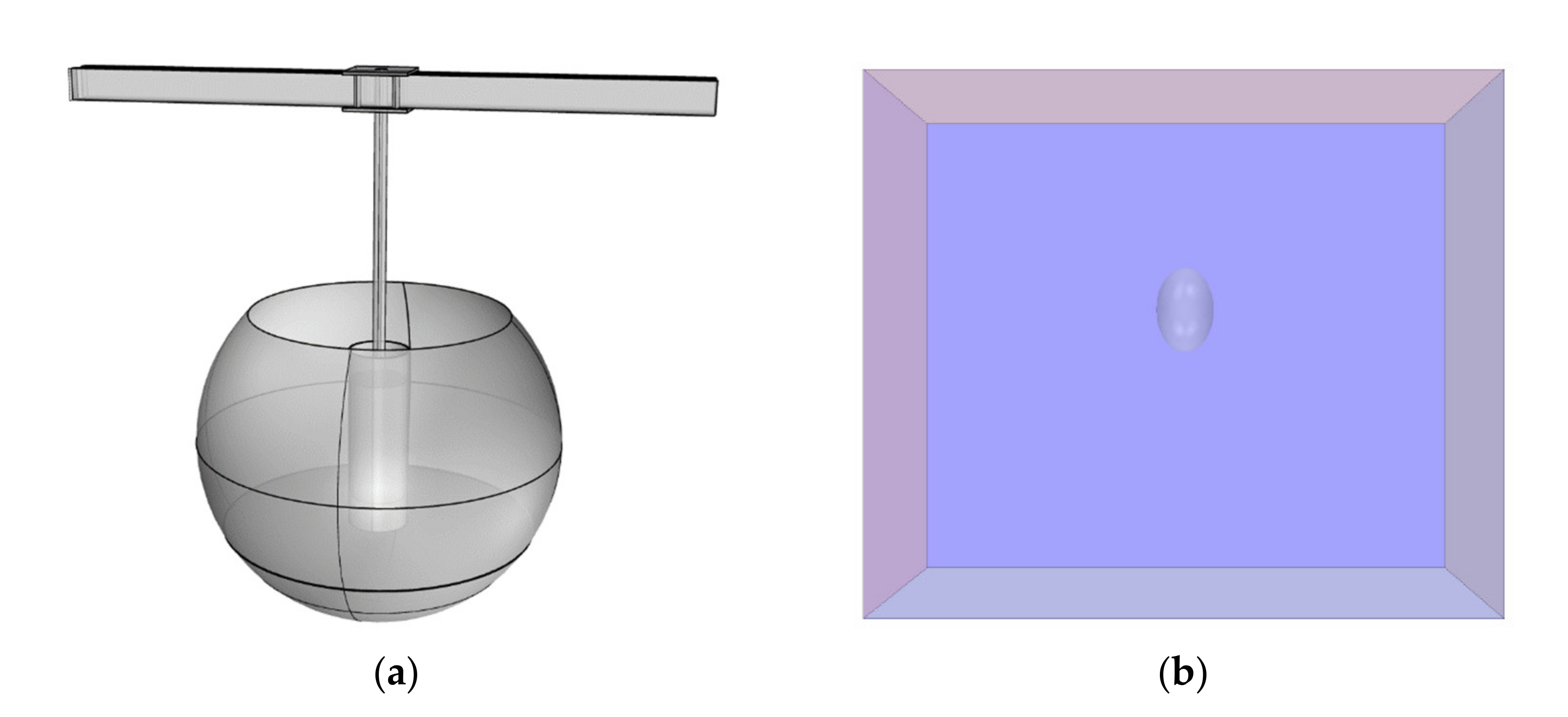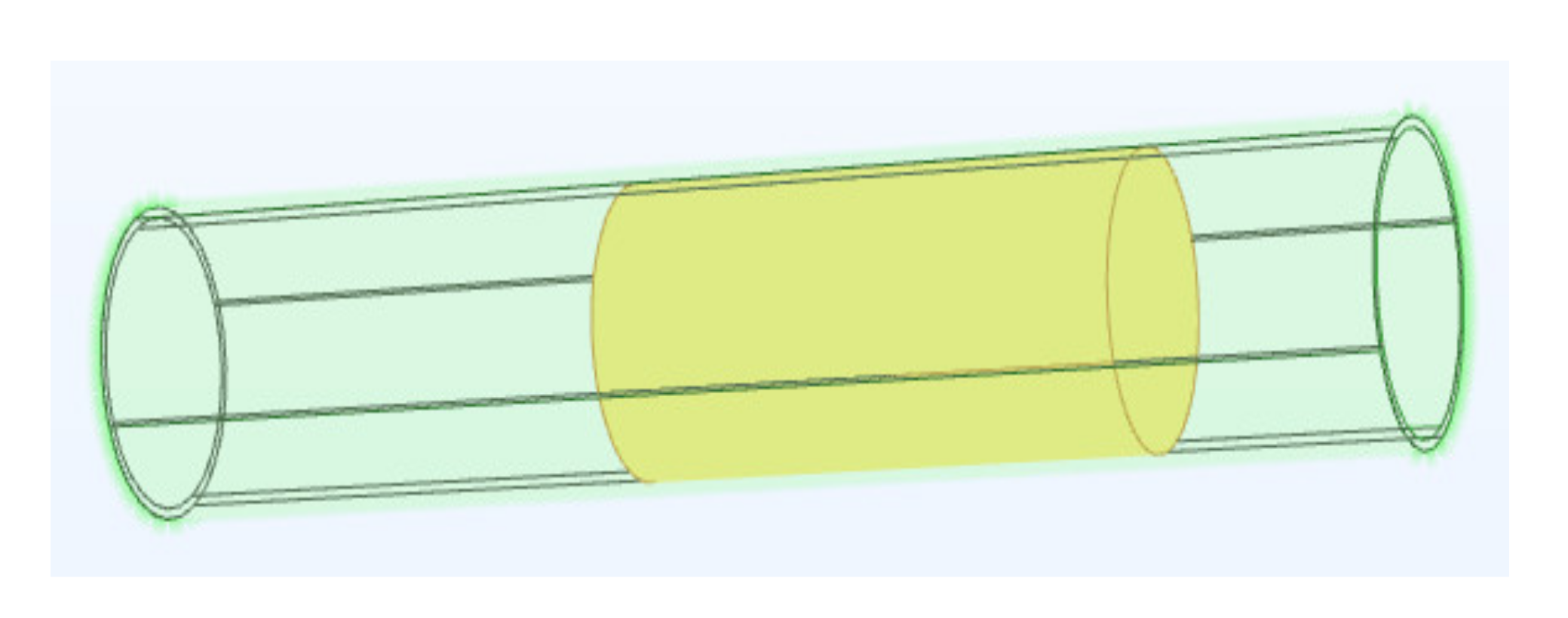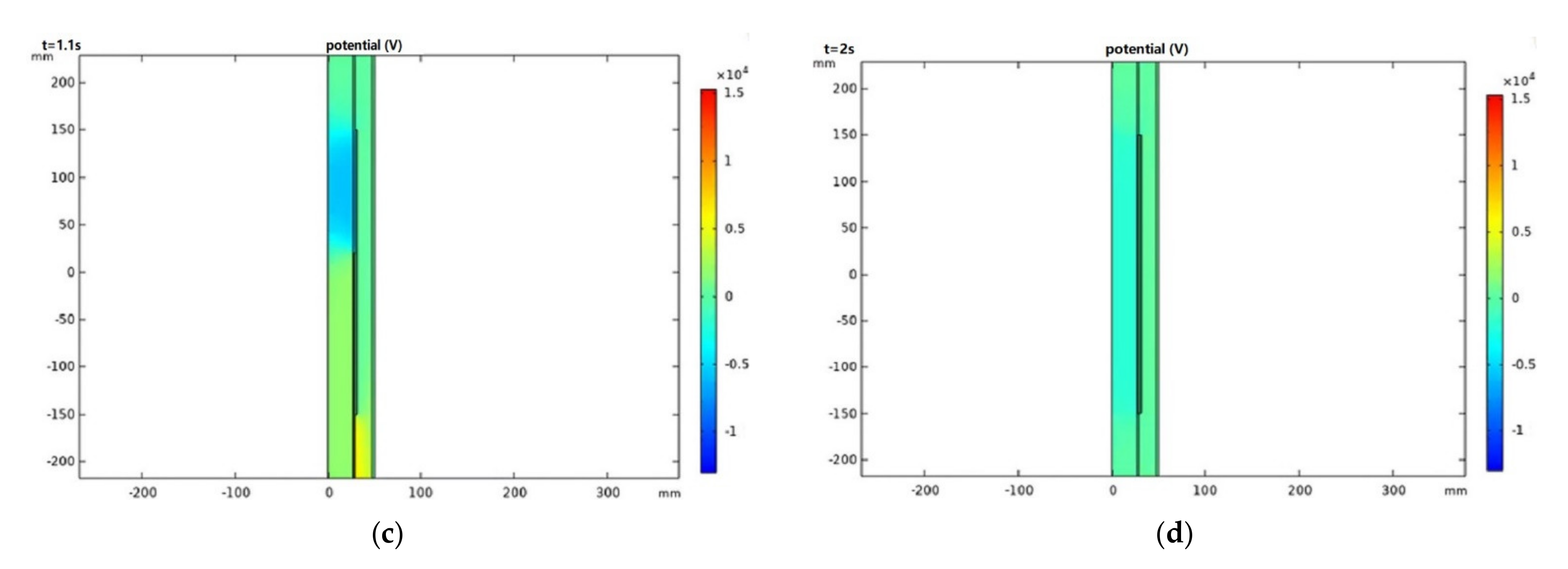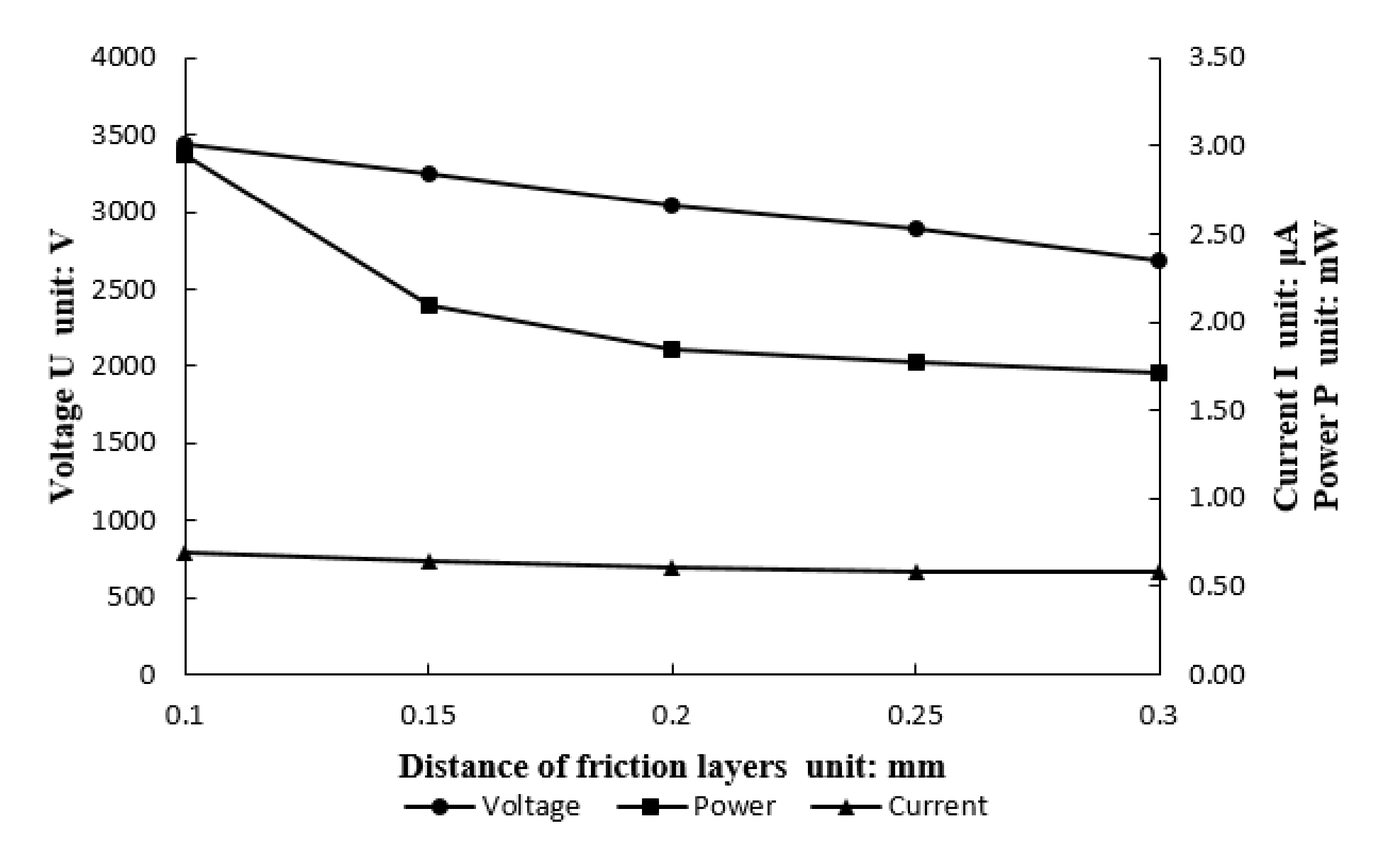Hydrodynamic and Energy Capture Properties of a Cylindrical Triboelectric Nanogenerator for Ocean Buoy
Abstract
1. Introduction
2. Methods and Model
Model of BUOY-41 with a Built-In C-TENG
3. Results and Discussions
3.1. Hydrodynamic Properties of Ocean Buoy
3.2. Energy Capture Properties of C-TENG
3.2.1. Electric Potential Distribution
3.2.2. Influence of Resistance
3.2.3. Influence of Friction Layer Distance
3.2.4. Influence of Friction Charge Density
4. Conclusions
Author Contributions
Funding
Institutional Review Board Statement
Informed Consent Statement
Data Availability Statement
Conflicts of Interest
References
- Khaligh, A.; Onar, O.C. Energy Harvesting: Solar, Wind, and Ocean Energy Conversion Systems; Taylor Francis Group: Abingdon, UK, 2017; pp. 1–368. [Google Scholar]
- Gielen, D.; Boshell, F.; Saygin, D. Climate and energy challenges for materials science. Nat. Mater. 2016, 15, 117–120. [Google Scholar] [CrossRef] [PubMed]
- Chu, S.; Majumdar, A. Opportunities and challenges for a sustainable energy future. Nat. Cell Biol. 2012, 488, 294–303. [Google Scholar] [CrossRef] [PubMed]
- Astariz, S.; Iglesias, G. The economics of wave energy: A review. Renew. Sustain. Energy Rev. 2015, 45, 397–408. [Google Scholar] [CrossRef]
- Xu, G.; Shen, W.; Wang, X. Applications of Wireless Sensor Networks in Marine Environment Monitoring: A Survey. Sensors 2014, 14, 16932–16954. [Google Scholar] [CrossRef]
- Yuh, J.; Marani, G.; Blidberg, D.R. Applications of marine robotic vehicles. Intell. Serv. Robot. 2011, 4, 221–231. [Google Scholar] [CrossRef]
- Salter, S.H. Wave power. Nat. Cell Biol. 1974, 249, 720–724. [Google Scholar] [CrossRef]
- Falnes, J. A review of wave-energy extraction. Mar. Struct. 2007, 20, 185–201. [Google Scholar] [CrossRef]
- Von Jouanne, A. Harvesting the waves. Mech. Eng. Mag. Sel. Artic. 2006, 128, 24–27. [Google Scholar] [CrossRef]
- Drouen, L.; Charpentier, J.F.; Semail, E.; Clenet, S.B.T.-O. Study of an Innovative Fitted to Marine Current Turbines. In OCEANS 2007-Europe; IEEE: New York, NY, USA, 18 June 2007; pp. 1–6. [Google Scholar]
- Fan, F.-R.; Tian, Z.-Q.; Wang, Z.L. Flexible triboelectric generator. Nano Energy 2012, 1, 328–334. [Google Scholar] [CrossRef]
- Xiang, C.; Liu, C.; Hao, C.; Wang, Z.; Che, L.; Zhou, X. A self-powered acceleration sensor with flexible materials based on triboelectric effect. Nano Energy 2017, 31, 469–477. [Google Scholar] [CrossRef]
- Niu, S.; Wang, Z.L. Theoretical systems of triboelectric nanogenerators. Nano Energy 2015, 14, 161–192. [Google Scholar] [CrossRef]
- Jiang, T.; Chen, X.; Han, C.B.; Tang, W.; Wang, Z.L. Theoretical Study of Rotary Freestanding Triboelectric Nanogenerators. Adv. Funct. Mater. 2015, 25, 2928–2938. [Google Scholar] [CrossRef]
- Yang, H.; Liu, W.; Xi, Y.; Lai, M.; Guo, H.; Liu, G.; Wang, M.; Li, T.; Ji, X.; Li, X. Rolling friction contact-separation mode hybrid triboelectric nanogenerator for mechanical energy harvesting and self-powered multifunctional sensors. Nano Energy 2018, 47, 539–546. [Google Scholar] [CrossRef]
- Xia, K.; Zhu, Z.; Zhang, H.; Du, C.; Fu, J.; Xu, Z. Milk-based triboelectric nanogenerator on paper for harvesting energy from human body motion. Nano Energy 2019, 56, 400–410. [Google Scholar] [CrossRef]
- Gu, G.Q.; Han, C.B.; Tian, J.J.; Lu, C.X.; He, C.; Jiang, T.; Li, Z.; Wang, Z.L. Antibacterial composite film-based triboelectric nan-ogenerator for harvesting walking energy. ACS Appl. Mater. Interfaces 2017, 9, 11882. [Google Scholar] [CrossRef] [PubMed]
- Liu, G.X.; Li, W.J.; Liu, W.B.; Bu, T.Z.; Guo, T.; Jiang, D.D.; Zhao, J.Q.; Ben Xi, F.; Hu, W.G.; Zhang, C. Soft Tubular Triboelectric Nanogenerator for Biomechanical Energy Harvesting. Adv. Sustain. Syst. 2018, 2, 1800081. [Google Scholar] [CrossRef]
- Chen, B.; Tang, W.; Jiang, T.; Zhu, L.; Chen, X.; He, C.; Xu, L.; Guo, H.; Lin, P.; Li, D.; et al. Three-dimensional ultra-flexible triboelectric nanogenerator made by 3D printing. Nano Energy 2018, 45, 380–389. [Google Scholar] [CrossRef]
- Tang, W.; Han, C.B.; Zhang, C.; Wang, Z.L. Cover-sheet-based nanogenerator for charging mobile electronics using low-frequency body motion/vibration. Nano Energy 2014, 9, 121–127. [Google Scholar] [CrossRef]
- Wang, J.; Ding, W.; Pan, L.; Wu, C.; Yu, H.; Yang, L.; Liao, R.; Wang, Z.L. Self-Powered Wind Sensor System for Detecting Wind Speed and Direction Based on a Triboelectric Nanogenerator. ACS Nano 2018, 12, 3954–3963. [Google Scholar] [CrossRef]
- Wang, P.; Pan, L.; Wang, J.; Xu, M.; Dai, G.; Zou, H.; Dong, K.; Wang, Z.L. An Ultra-Low-Friction Triboelectric–Electromagnetic Hybrid Nanogenerator for Rotation Energy Harvesting and Self-Powered Wind Speed Sensor. ACS Nano 2018, 12, 9433–9440. [Google Scholar] [CrossRef]
- Zhang, C.; Zhang, Z.H.; Yang, X.; Zhou, T.; Han, C.B.; Wang, Z.L. Tribotronic Phototransistor for Enhanced Photodetection and Hybrid Energy Harvesting. Adv. Funct. Mater. 2016, 26, 2554–2560. [Google Scholar] [CrossRef]
- Zheng, L.; Lin, Z.-H.; Cheng, G.; Wu, W.; Wen, X.; Lee, S.; Wang, Z.L. Silicon-based hybrid cell for harvesting solar energy and raindrop electrostatic energy. Nano Energy 2014, 9, 291–300. [Google Scholar] [CrossRef]
- Wijewardhana, K.R.; Shen, T.-Z.; Jayaweera, E.; Shahzad, A.; Song, J.-K. Hybrid nanogenerator and enhancement of water–solid contact electrification using triboelectric charge supplier. Nano Energy 2018, 52, 402–407. [Google Scholar] [CrossRef]
- Liu, Y.; Sun, N.; Liu, J.; Wen, Z.; Sun, X.; Lee, S.-T.; Sun, B. Integrating a Silicon Solar Cell with a Triboelectric Nanogenerator via a Mutual Electrode for Harvesting Energy from Sunlight and Raindrops. ACS Nano 2018, 12, 2893–2899. [Google Scholar] [CrossRef]
- Jiang, T.; Zhang, L.M.; Chen, X.; Han, C.B.; Tang, W.; Zhang, C.; Xu, L.; Wang, Z.L. Structural optimization of triboelectric nan-ogenerator for harvesting water wave energy. ACS Nano 2015, 9, 12562–12572. [Google Scholar] [CrossRef]
- Zhang, L.M.; Han, C.B.; Jiang, T.; Zhou, T.; Li, X.H.; Zhang, C.; Wang, Z.L. Multilayer wavy-structured robust triboelectric nan-ogenerator for harvesting water wave energy. Nano Energy 2016, 22, 87–94. [Google Scholar] [CrossRef]
- Ouro, P.; Juez, C.; Franca, M. Drivers for mass and momentum exchange between the main channel and river bank lateral cavities. Adv. Water Resour. 2020, 137, 103511. [Google Scholar] [CrossRef]
- Ballard, Z.; Mann, B. Experimental and Numerical Investigations of an Untethered, Nonlinear Spherical Buoy in a Wave Tank. In Proceedings of the International Design Engineering Technical Conferences and Computers and Information in Engineering Conference, Washington, DC, USA, 28–31 August 2011; Volume 54785, pp. 429–437. [Google Scholar]
- Ballard, Z.; Mann, B.P. Two-Dimensional Nonlinear Analysis of an Untethered Spherical Buoy Due to Wave Loading. J. Comput. Nonlinear Dyn. 2013, 8, 041019. [Google Scholar] [CrossRef]
- David, F.G.; Murray, R.; Raymond, C.Z. Cohen Wave interaction with a tethered buoy: SPH simulation and experimental validation. Ocean Eng. 2018, 156, 306–317. [Google Scholar]
- Lin, H.; Yim, S.C. Coupled Surge-Heave Motions of a Moored System. I: Model Calibration and Parametric Study. J. Eng. Mech. 2006, 132, 671–680. [Google Scholar] [CrossRef]
- Zhu, X.; Yoo, W.S. Numerical modeling of a spherical buoy moored by a cable in three dimensions. Chin. J. Mech. Eng. 2016, 29, 588–597. [Google Scholar] [CrossRef]
- Zhu, X.; Yoo, W.S. Dynamic analysis of a floating spherical buoy fastened by mooring cables. Ocean Eng. 2016, 121, 462–471. [Google Scholar] [CrossRef]
- Yang, W.; Wang, X.; Li, H.; Wu, J.; Hu, Y.; Li, Z.; Liu, H. Fundamental research on the effective contact area of micro-/nano-textured surface in triboelectric nanogenerator. Nano Energy 2019, 57, 41–47. [Google Scholar] [CrossRef]
- Niu, S.; Liu, Y.; Chen, X.; Wang, S.; Zhou, Y.S.; Lin, L.; Xie, Y.; Wang, Z.L. Theory of freestanding triboelectric-layer-based nanogenerators. Nano Energy 2015, 12, 760–774. [Google Scholar] [CrossRef]
- Niu, S.; Wang, S.; Liu, Y.; Zhou, Y.S.; Lin, L.; Hu, Y.; Pradel, K.C.; Wang, Z.L. A theoretical study of grating structured triboelectric nanogenerators. Energy Environ. Sci. 2014, 7, 2339–2349. [Google Scholar] [CrossRef]
- Wei, Z.; Geng, L.; Bian, S. Equivalent circuit models of triboelectric nanogenerators. ZTE Technol. 2018. [Google Scholar] [CrossRef]
- Zhang, D.; Shi, J.; Si, Y.; Li, T. Multi-grating triboelectric nanogenerator for harvesting low-frequency ocean wave energy. Nano Energy 2019, 61, 132–140. [Google Scholar] [CrossRef]
- Lin, W.Z.; Han, C.B.; Jiang, T.; Zhang, C.; Wang, Z.L. A ball-bearing structured triboelectric nanogenerator for nondestructive damage and rotating speed measurement. Nanotechnology 2016, 27, 085401. [Google Scholar] [CrossRef]
- Liu, W.; Xu, L.; Bu, T.; Yang, H.; Liu, G.; Li, W.; Pang, Y.; Hu, C.; Zhang, C.; Cheng, T. Torus structured triboelectric nanogenerator array for water wave energy harvesting. Nano Energy 2019, 58, 499–507. [Google Scholar] [CrossRef]
- Han, C.B.; Du, W.; Zhang, C.; Tang, W.; Zhang, L.; Wang, Z.L. Harvesting energy from automobile brake in contact and non-contact mode by conjunction of triboelectrication and electrostatic-induction processes. Nano Energy 2014, 6, 59–65. [Google Scholar] [CrossRef]










Publisher’s Note: MDPI stays neutral with regard to jurisdictional claims in published maps and institutional affiliations. |
© 2021 by the authors. Licensee MDPI, Basel, Switzerland. This article is an open access article distributed under the terms and conditions of the Creative Commons Attribution (CC BY) license (https://creativecommons.org/licenses/by/4.0/).
Share and Cite
Liu, H.; Yan, F.; Jin, Y.; Liu, W.; Chen, H.; Kong, F. Hydrodynamic and Energy Capture Properties of a Cylindrical Triboelectric Nanogenerator for Ocean Buoy. Appl. Sci. 2021, 11, 3076. https://doi.org/10.3390/app11073076
Liu H, Yan F, Jin Y, Liu W, Chen H, Kong F. Hydrodynamic and Energy Capture Properties of a Cylindrical Triboelectric Nanogenerator for Ocean Buoy. Applied Sciences. 2021; 11(7):3076. https://doi.org/10.3390/app11073076
Chicago/Turabian StyleLiu, Hengxu, Feng Yan, Yeqing Jin, Weiqi Liu, Hailong Chen, and Fankai Kong. 2021. "Hydrodynamic and Energy Capture Properties of a Cylindrical Triboelectric Nanogenerator for Ocean Buoy" Applied Sciences 11, no. 7: 3076. https://doi.org/10.3390/app11073076
APA StyleLiu, H., Yan, F., Jin, Y., Liu, W., Chen, H., & Kong, F. (2021). Hydrodynamic and Energy Capture Properties of a Cylindrical Triboelectric Nanogenerator for Ocean Buoy. Applied Sciences, 11(7), 3076. https://doi.org/10.3390/app11073076





